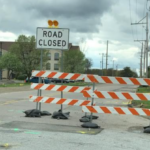 11/05/10 With snow flurries back in the Indiana forecast for the first time this year, public safety officials are reminding Hoosier motorists of a few tips to help get ready for the coming winter.
11/05/10 With snow flurries back in the Indiana forecast for the first time this year, public safety officials are reminding Hoosier motorists of a few tips to help get ready for the coming winter.
The Indiana Department of Homeland Security (IDHS), Indiana Department of Transportation (INDOT) and Indiana State Police (ISP) affirm that all Hoosier motorists need to prepare vehicles in preparation for difficult winter travel conditions.
Drivers are encouraged to follow these tips to winterize vehicles:
- Check tire pressure and tread depth. Use a pressure gauge and measure tire tread depth to ensure good traction. Consult your owner’s manual for advice. Look for uneven wearing which can also be dangerous.
- Check battery, exhaust system, heater and defroster. Make sure the battery is not past its lifespan, and that the terminals are tight and free of corrosion. Hoses and belts should be inspected for cracks. Now is the time to discover if your heater is broken – not when the temperature drops.
- Check antifreeze. Make sure that a 50 percent antifreeze, 50 percent water mixture is at the proper radiator level. If the coolant is two years old, get it flushed and refilled.
- Change oil every 3,000-5,000 miles. Consider using a lighter, “winter weight” oil. Refer to your owner’s manual for guidance.
- Check windshield wipers and blades: Replace the blades twice a year and make sure extra wiper fluid is on hand.
- Ensure the four-wheel drive system and brakes are functioning properly.
- It is a good idea to keep at least a half tank of gas in your car at all times during the winter months, to keep the fuel lines from freezing.
Even with the best maintenance and cautious driving, snow, ice and freezing temperatures can sometimes still get the best of your vehicle. Hazardous winter driving conditions induce crashes, which are the leading cause of death during winter storms. Being prepared to handle potential slide-offs, crashes, and car trouble in winter is a simple but crucial step to take in preparing for the next few months.
Prepare a winter emergency kit for your vehicle. Supplies should include:
- At least two blankets or a sleeping bag
- Flashlight or battery-powered lantern and extra batteries
- Booster (jumper) cables
- Emergency flares
- Extra clothing, particularly boots, hats and mittens
- A steel shovel and rope to use as a lifeline
- Bottled water or juice and nonperishable high-energy foods (granola bars, raisins, nuts, peanut butter or cheese crackers)
- Thermos or container that won’t allow liquids to freeze
- First-aid kit and necessary medications
- Sand or non-clumping cat litter for tire traction if your vehicle gets stuck in snow or ice
- A cell phone charger which can be adapted to vehicle use
- Ice scraper and snow brush
- Tire repair kit and pump
- Candle, matches, heat sticks/packs, lighters, hand-warmers, etc. (Be sure to crack the window if you using a heat source inside the vehicle)
Leadership for a Safe and Secure Indiana














